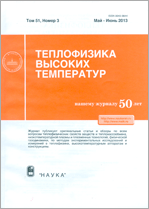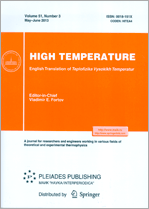|
|
Teplofizika vysokikh temperatur, 2012, Volume 50, Issue 1, Pages 3–17
(Mi tvt222)
|
|
|
 |
This article is cited in 8 scientific papers (total in 8 papers)
Plasma Investigations
The corona discharge in nuclear excited plasma as a way of obtaining ordered dust particle structures
O. A. Sinkevich, L. V. Deputatova, V. S. Filinov, V. E. Fortov, V. N. Naumkin, V. I. Vladimirov, V. I. Meshakin, V. A. Rykov
Joint Institute for High Temperatures, Russian Academy of Sciences, Moscow, Russia
Abstract:
A model of a corona discharge in a nuclear excited dust plasma at the pressures of 1–100 atm is proposed. The distributions of the electric field and current-voltage characteristics of a corona discharge in a nuclear-excited dust plasma are found for a particular cylindrical geometry case at different methods of corona-producing electrode positioning. The conditions for the existence of a stationary corona discharge are obtained. A mathematical model describing the behavior of dust particles in a nuclear plasma that allows taking into account the key physical processes occurring in a nuclear-excited dust plasma is considered. The analyzed plasma properties are as follows: (1) shielding of the Coulomb forces of the interaction between dust particles, (2) the energy exchange and the stochastic character of the dust particle interaction with a buffer gas and ambient plasma, and (3) strong spatial inhomogeneity of the nuclear-excited plasma. The use of a corona discharge in a nuclear-excited plasma will make it possible to ensure stability of plasma-dust structures and more efficient conversion of the nuclear energy into laser radiation.
Received: 23.06.2010
Citation:
O. A. Sinkevich, L. V. Deputatova, V. S. Filinov, V. E. Fortov, V. N. Naumkin, V. I. Vladimirov, V. I. Meshakin, V. A. Rykov, “The corona discharge in nuclear excited plasma as a way of obtaining ordered dust particle structures”, TVT, 50:1 (2012), 3–17; High Temperature, 50:1 (2012), 1–14
Linking options:
https://www.mathnet.ru/eng/tvt222 https://www.mathnet.ru/eng/tvt/v50/i1/p3
|


| Statistics & downloads: |
| Abstract page: | 340 | | Full-text PDF : | 114 | | References: | 78 |
|





 Contact us:
Contact us: Terms of Use
Terms of Use
 Registration to the website
Registration to the website Logotypes
Logotypes







 Citation in format
Citation in format 
